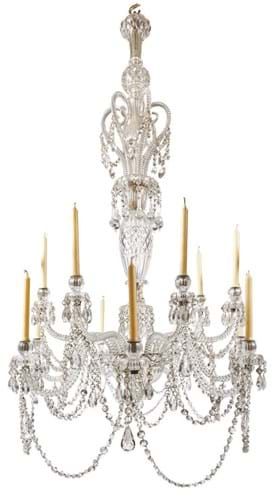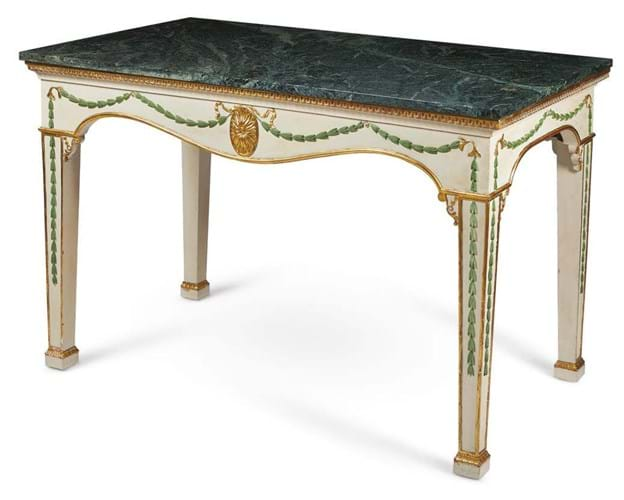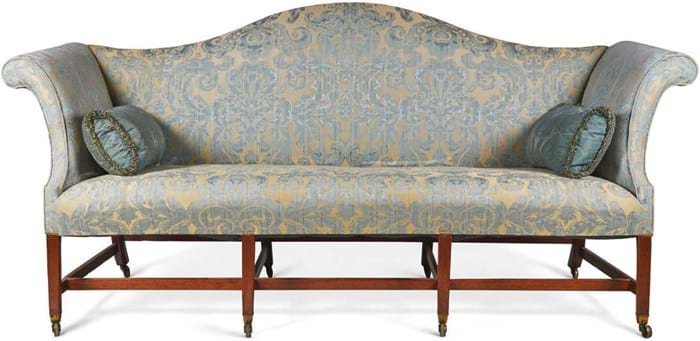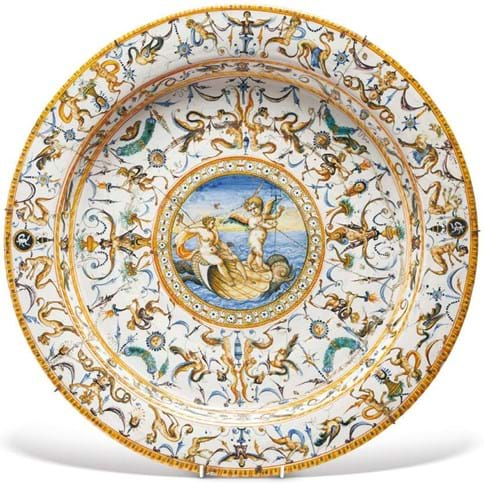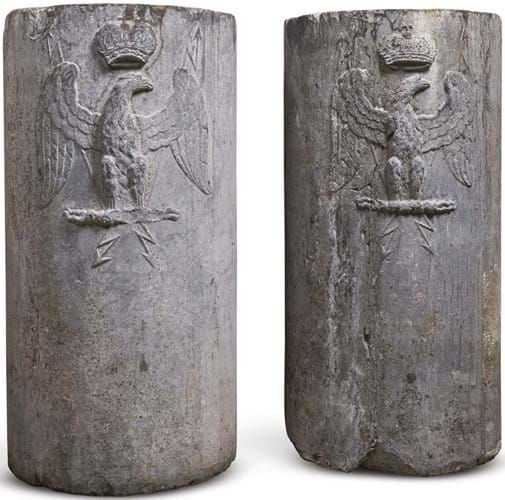Held on successive days on October 3-4, the 297 lots from Flaxley Abbey, with a £29,000 George II lead figural sundial as star, totalled £702,000 hammer, and the 159 from Chilham Castle, led by a £38,000 matched pair of Charles II wall mirrors, notched up £465,000.
Messel touch of magic
Flaxley Abbey, a 12th century Forest of Dean Cistercian monastery, got its first rebuild after the Dissolution when new owner Sir William Kingston established a pattern of redesign and refurbishment by owners across the centuries, particular the Crawley-Boevy baronets who owned it from 1648-1960.
Their successors, local industrialist Frederick Baden Watkins and his wife Phyllis, could afford the best and in 1962 commissioned the most famous designer in Europe: Oliver Messel (1904-78).
Messel was a well-connected high-society artist and award-winning stage designer as well as an interior designer.
Most of the top-sellers at the October 3 sale were introduced by him to Flaxley; some from his own homes, some he designed for the abbey.
The contents – believed to have been consigned by the famously feuding children of the Watkinses who lived in different wings of Flaxley – were offered without reserve and, as a result, everything sold.
Leading the day was a £30,000 18th century Anglo-Dutch painting of an unidentified country house (see Art Market, ATG No 2566).
It was followed by the sundial attributed to John Cheere (1709-87) of Hyde Park, the go-to business for lead and plaster statues in the mid- 18th century.
After John Nost (London-based Flemish sculptor Jan van Nost, d.1729), the crouching figure of Father Time or Kronos held the dial signed B[enjamin] Martin London. Bearing the indistinctly engraved Boevy escutcheon and standing 5ft (1.52m) tall, it nearly doubled the top estimate at £29,000.
A UK bidder bought a pair of 20th century composition stone sphinxes after the model by Cheere. Supplied by Messel for the water gardens he designed at Flaxley, the 3ft 7in wide (1.09m) statues quadrupled expectations at £11,000.
Much of the sale reflected today’s trend towards the look rather than the age – Messel just got there 50 years earlier – most noticeably among the top lighting pieces which went to UK buyers.
Leading the section was a 5ft 9in (1.76m) high 20th century cut and moulded glass, 14-light chandelier that went for £13,000.
Also 20th century were a painted and giltwood and composition eight-light chandelier estimated at £300-500 which made £8500 online and a 3ft 2in (97cm) Regency-style gilt-metal lantern at a 10-times-low-estimate £8000.
Special designs
Furniture highlights included pieces designed for the project by Messel.
One was a set of 12 cream and green painted dining armchairs and six side chairs, with pierced trelliswork and filled backs and ring-turned legs. They suffered a number of knocks, chips and stains to the fabric but, estimated at £3000-5000, they made £24,000.
Another Messel design was a 20th century George III-style giltwood and painted console. Featuring a 4ft 2in wide x 2ft 5in deep (1.27m x 74cm) verde antico marble top above a shaped frieze, it was estimated at £1500-2000 and went to the UK buyer of the chairs at £13,000.
Antique seating furniture also had its moments. A c.1780, 7ft 6in (2.29m) wide mahogany sofa with arched padded back, out-scrolled armrests and square legs came from Messel’s family home and made £15,000 from an internet bidder, nearly eight times the top estimate.
The bargain of the day was a group of three late 17th century and later oak side chairs. Pitched at £600- 800, they sold at £10 to a UK private buyer. However, putting that tenner into perspective was the £7000 for a c.1740 and later walnut and upholstered wing armchair estimated at £600-800.
A Charles II oak chest of drawers went within estimate at £11,000. An elaborate enclosed example, c.1660, with cushion frieze above a single drawer and cupboard doors, it was painted and inlaid with bone and mother of pearl and stood 4ft 6in (1.36m) tall.
Ceramics stars
The stand-out ceramics were a late 16th or early 17th century maiolica charger, either Urbino or Nevers, and a 17th century German stoneware jug.
The 19in (48.5cm) diameter charger painted with Amphitrite and Cupid, bought at Christie’s in 1897, had come to Messel by descent. It had historic rivets having once been in six pieces but, against an £800- 1200 estimate, sold in the room at £12,500.
The 19½in (50cm) ‘Cardinal Bellamine’ jug, with three armorial panels alongside the traditional mask, went to at a six-times-top-estimate £4800.
The ‘King of Chelsea’
While Messel’s 12-year project at Flaxley was going on, a new interiors designer was rising to fame: Christopher Gibbs (1938-2018), the Chelsea antique dealer whose influence on men’s fashion as well as interiors led his being credited with inventing ‘Swinging London’ and being called ‘King of Chelsea‘.
In 2002 he and his team were commissioned to refurbish Chilham Castle near Canterbury.
Although the castle still has the 12th century keep, the house was built in 1616. The makeover was commissioned by financier Sir Stuart Wheeler (1935-2020) and his society photographer wife Tessa (1945-2017).
In contrast to Flaxley Abbey, the Chilham lots offered on October 4 were almost entirely antiques, although there was a handful of perennial 20th century favourites selling well on the phone or online to UK buyers.
Going at 10 times lower estimates were both a c.1920 Howard & Sons velvet upholstered armchair, with minor condition problems, at £3500 and a pair of 7ft (2.12m) wide sofas by Peter Dudgeon in the manner of Howard & Sons at £11,000.
On a day of strong demand for Continental material, the furniture was topped by a late 17th century, 2ft 7in (80cm) high walnut octagonal-top centre table.
Probably Italian, it bore the evidence of the years including some warping and bending to the top but, against a £10,000-20,000 estimate, it went to a Continental bidder at £32,000.
Underscoring a current demand for large sofas was the mid-18th century 10ft 4in (3.16m) wide, carved giltwood canapé à confidents. Catalogued only as ‘Continental’ and pitched at £5000-10,000, it went to a UK buyer against European interest at £30,000.
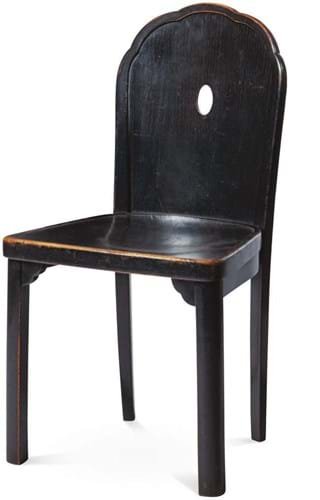
One of a pair of Austrian ebonised chairs branded Kohn – £12,000 at Dreweatts’ Chilham Castle auction.
A pair of Austrian Secessionist ebonised beech hall chairs was the sleeper of the furniture, selling at 30 times the mid-estimate. Each 3ft (91cm) tall chair was branded and had applied paper labels for Jacob Kohn (1791-1866) and son Josef (1814-84).
The chairs were catalogued simply as late 19th/early 20th century and estimated at £300-500. But they can probably be attributed to the Wiener Werkstätte designer Josef Hoffman. They sold to a US institution at £12,000.
Italian furniture met a mixed response but well above estimate was a late 18th/early 19th century north Italian, possibly Tyrolean, walnut, ebonised and bone-inlaid armoire.
Paper labels showed it had been brought back to England by the Earl of Dulcie for his Gloucestershire home in 1840. Pitched at £1500- 7000, it was a UK buy at £7000.
Stand-alone features
Gibbs’ personal credo – ‘I don’t approve of the mean look, but I do approve of the spare look, where every little bit is telling’ – was reflected in his placing of a number of free-standing pedestals at Chilham.
A pair of 18th or 19th century French grey stone cylindrical pedestals, 2ft 9in tall and 16in diameter (83 x 41cm), were relief carved with a crowned eagle clasping a lightning bolt, had minor condition problems but sold to a UK buyer at a triple-estimate £9000.
A pair of 19th century variegated dove grey marble Solomonic twisted columns, 4ft 11in (1.5m) on fairly modern and chipped composite bases, went to the Continent at a 10-times-low-estimate £8000 and a late 19th/early 20th century, 3ft (91cm) tall, solid tulipwood square-section pedestals with old splits went to the UK online at £5500, well above the £800-1200 guide.



